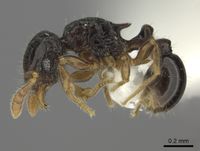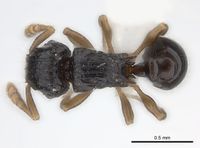Tetramorium trirugosum
| Tetramorium trirugosum | |
|---|---|

| |
| Scientific classification | |
| Kingdom: | Animalia |
| Phylum: | Arthropoda |
| Class: | Insecta |
| Order: | Hymenoptera |
| Family: | Formicidae |
| Subfamily: | Myrmicinae |
| Tribe: | Crematogastrini |
| Genus: | Tetramorium |
| Species: | T. trirugosum |
| Binomial name | |
| Tetramorium trirugosum Hita Garcia, Fischer & Peters, 2010 | |
Specimens have been collected from leaf litter in rainforest.
Identification
Tetramorium trirugosum is easily recognizable within the muralti complex because of the entire and convex anterior clypeal margin, short antennal scape (SI 65 - 70), uniformly dark brown coloration, and most importantly, at least 3 very strong longitudinal rugae on the mesosomal dorsum.
A member of the Afrotropical muralti species complex, which is part of the weitzeckeri species group.
Keys including this Species
Distribution
Known from Cameroun and Gabon.
Latitudinal Distribution Pattern
Latitudinal Range: 3.969166667° to 2.566944444°.
| North Temperate |
North Subtropical |
Tropical | South Subtropical |
South Temperate |
- Source: AntMaps
Distribution based on Regional Taxon Lists
Afrotropical Region: Cameroun (type locality).
Distribution based on AntMaps
Distribution based on AntWeb specimens
Check data from AntWeb
Countries Occupied
| Number of countries occupied by this species based on AntWiki Regional Taxon Lists. In general, fewer countries occupied indicates a narrower range, while more countries indicates a more widespread species. |

|
Estimated Abundance
| Relative abundance based on number of AntMaps records per species (this species within the purple bar). Fewer records (to the left) indicates a less abundant/encountered species while more records (to the right) indicates more abundant/encountered species. |

|
Biology
Castes
Nomenclature
The following information is derived from Barry Bolton's Online Catalogue of the Ants of the World.
- trirugosum. Tetramorium trirugosum Hita Garcia, Fischer & Peters, 2010b: 62, figs. 4A, 5A, 70-72 (w.) CAMEROUN.
Unless otherwise noted the text for the remainder of this section is reported from the publication that includes the original description.
Tetramorium trirugosum can be placed together with Tetramorium flavithorax and intermedium because they are the only species in the complex with regular longitudinal rugae on the mesosomal dorsum. Of these any confusion with T. flavithorax is unlikely since this species shows a remarkable bicoloured pattern while T. trirugosum is uniformly brown to dark brown. It has to be noted that some specimens of T. trirugosum showed a fully longitudinally rugose mesosoma and could at first glance be confused with T. intermedium. However, the latter species possesses a much longer antennal scape (SI 74 - 81) and a much thicker petiolar node (DPeI 179 - 212, LPeI 40 - 45). Not considering sculpturation T. trirugosum is also superficially morphologically related to Tetramorium muralti though they can be well separated. The petiolar node of T. trirugosum is more transverse and thin (DPeI 257 - 300) than in T. muralti (DPeI 224 - 257). The opposite pattern can be observed for the postpetiole that is less antero-posteriorly compressed and more rounded in T. trirugosum (DPpI 150 - 169) than in T. muralti (DPpI 173 - 192). Additionally, the appendage coloration is also different. Antennae, mandibles, and legs of T. muralti in Gabon are always uniformly yellowish, and in Cameroon brown except for the whitish tibiae, whereas the appendage coloration of T. trirugosum is always uniformly brown. However, the easiest differentiation in this case is the cephalic and mesosomal sculpturation that greatly varies from one to the other species. The remaining species in the complex either possess an impressed anterior clypeal margin, or a completely unsculptured mesosoma, or both, thus cannot be confused with T. trirugosum.
Description
Worker
HL 0.456 - 0.517 (0.494); HW 0.428 - 0.489 (0.466); SL 0.289 - 0.339 (0.315); EL 0.094 - 0.111 (0.105); PW 0.356 - 0.411 (0.390); WL 0.500 - 0.600 (0.566); PSL 0.117 - 0.167 (0.147 ); PTL 0.067 - 0.083 (0.076); PTH 0.189 - 0.222 (0.207); PTW 0.178 - 0.233 (0.206); PPL 0.122 - 0.156 (0.144); PPH 0.178 - 0.211 (0.193); PPW 0.200 - 0.256 (0.231); CI 89 - 97 (94); SI 65 - 70 (68); OI 21 - 24 (23); PSLI 25 - 33 (30); PeNI 49 - 57 (53); LPeI 34 - 42 (37); DPeI 257 - 300 (271); PpNI 56 - 62 (59); LPpI 69 - 80 (75); DPpI 150 - 169 (160); PPI 102 - 119 (112) (18 measured).
Head longer than wide (CI 89 - 97). Anterior clypeal margin entire and convex. Frontal carinae strongly developed and sinuate, curving down ventrally between eye level and posterior margin of head to form the posterior and ventral margins of antennal scrobe. Scrobe well-developed, very broad and relatively deep, with distinct sharp margin all around. Antennal scape relatively short (SI 65 - 70). Eyes small to moderate (OI 21 - 24), with 6 to 7 ommatidia in longest row. Metanotal groove not impressed. Propodeal spines long, spinose, acute, and weakly down-curved (PSLI 25 - 33). Propodeal lobes small, triangular with an acute apex. Petiolar node squamiform, in dorsal view between 2.5 to 3 times wider than long (DPeI 257 - 300) and in lateral view between 2.4 to 2.9 times higher than long (LPeI 34 - 42). Postpetiole weakly cuneiform, more rounded, in dorsal view around 1.6 times wider than long (DPpI 150 - 169); in profile around 1.3 times higher than long (LPpI 69 - 80). Mandibles unsculptured, smooth and shiny. Clypeus generally with 3 longitudinal rugae and one distinct transverse median ruga, sometimes irregularly shaped. Head usually with 5 to 6 widely spaced longitudinal rugae between frontal carinae, generally running to posterior margin of head, rugae often interrupted or short, generally longitudinal rugae without any cross-meshes, sometimes region near posterior margin of head weakly rugo-reticulate, antennal scrobe with median longitudinal ruga anteriorly running at most to posterior eye level. Dorsum of mesosoma with at least 3 to 4 strong longitudinal rugae running from bases of propodeal spines to anterior pronotal dorsum, usually unbroken and strongly developed, sometimes more but weaker and more irregular rugae present, too. Lateral mesosoma partly smooth and partly irregularly longitudinally rugose. Ground sculpturation on head and mesosoma smooth and shiny. Both waist segments and gaster completely unsculptured, smooth and shiny. All dorsal body surfaces with simple, fine, long, and erect hairs. Pubescence on tibiae and antennal scapes decumbent to subdecumbent. Coloration uniformly dark brown to nearly black, appendages brown.
Type Material
Holotype worker, CAMEROON, Bimbia Forest, 7.4 km 119° ESE Limbe, 03° 58.9’ N, 09° 15.8’ E, 40m, sifted litter (leaf mold. rotten wood), rain forest, 14.iv.2000, leg. B.L. Fisher (California Academy of Sciences: CASENT0218391). Paratypes, 8 workers with same location data as holotype (CASC: CASENT0218387, CASENT0218388, CASENT0218389, CASENT0218390, CASENT0218391; Musee d'Histoire Naturelle Genève: 1 worker CASENT0218392 ; Naturhistorisches Museum, Basel: 1 worker CASENT0218393; Zoologisches Forschungsinstitut und Museum Alexander König: 1 worker CASENT0218412); 6 workers from CAMEROON, Res. Campo, 2.16km 106° ESE Ébodjé, 2°34.1 N, 9°50.7'E, 10m, sifted litter (leaf mold. rotten wood), littoral rain forest, 9.IV.2000, leg. B.L. Fisher (CASC: 7 workers CASENT0218413, CASENT0218414, CASENT0218415, CASENT0218416, CASENT0218417, CASENT0218418, CASENT0218385); 1 worker from CAMEROON, Bondé Forest, N'kolo village, 27.5 km 155° SSE Elogbatindi, 03° 13' 18 N, 010° 14' 48 E, 40m, sifted litter (leaf mold. rotten wood), rain forest, 12.IV.2000, leg. B.L. Fisher (CASC: CASENT0218386).
Etymology
The species epithet refers to the three conspicuous rugae on the mesosomal dorsum.
References
- Hita Garcia, F.; Fischer, G.; Peters, M. K. 2010. Taxonomy of the Tetramorium weitzeckeri species group (Hymenoptera: Formicidae) in the Afrotropical zoogeographical region. Zootaxa 2704:1-90.
References based on Global Ant Biodiversity Informatics
- Hita Garcia F., G. Fischer, and M. K. Peters. 2010. Taxonomy of the Tetramorium weitzeckeri species group (Hymenoptera: Formicidae) in the Afrotropical zoogeographical region. Zootaxa 2704: 1-90.


